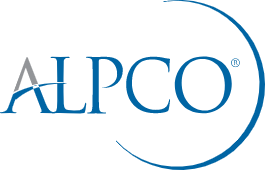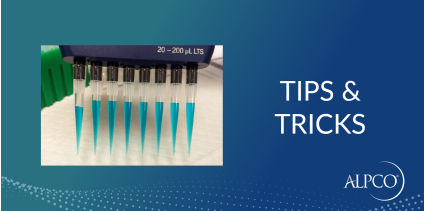12 ELISA Tips and Tricks: An Expert’s Guide to Improve Your Technique
The Enzyme-Linked Immunosorbent Assay (ELISA) is a proven sensitive method for detecting and quantifying specific biomarkers in a wide range of clinical and research samples. The accuracy and precision of ELISAs can be affected by many factors, including pipetting, washing, and sample-handling techniques. The experts at ALPCO have assembled some tips to remember, tricks to try, and demonstrational videos to help maximize ELISA performance. Our guide reviews proper pipetting and plate washing techniques, reconstituting lyophilized ELISA reagents, sample handling, and much more.ELISA Tip 1: Use a Dilution Plat
ELISA Tip 1: Use a Dilution Plate to Prepare Dilutions
Most immunoassays require the dilution of samples to reduce matrix effects or bring the analyte concentration in the sample within the detectable range of the assay. It is often best to set up a dilution plate or microtubes with standards, controls, and your diluted samples. This allows for the careful preparation of dilutions and the rapid transfer of reagents to the assay plate, reducing errors and minimizing variation in incubation time across the plate. Remember these tips when preparing a dilution plate:
-
Prepare all dilutions in microtiter tubes such as the Simport Scientific Biotube™ Microtiter Tube System, or a dilution plate such as the Fisherbrand™ 96-Well DeepWell™ Polypropylene Microplate.
-
Transfer prepared standards, controls, and samples to the assay plate using a multichannel pipette.
Dilution Plate Trick: When performing subsequent sample dilutions, consider placing sample dilutions in adjacent columns in the dilution plate or microtiter tubes to facilitate the use of a multichannel pipette. For example, adding initial 1:5 dilution in columns 2 and 4 and 1:20 dilution in columns 3 and 5. Be sure to calculate sufficient volume for your 1:5 dilution to accommodate preparation of the 1:20 dilution and addition of all 1:5 replicates to the plate.
ELISA Tip 2: Use a Multichannel Pipette to Add Reagents to Your Assay Plate
Using a multichannel pipette typically yields improved consistency by reducing pipetting errors and decreasing variability in incubation time from the beginning to the end of the plate. It also reduces repetitive motion. Follow these tips when using a multichannel pipette to add reagents to an ELISA plate:
-
Prepare standards, controls, and samples in microtiter tubes or a dilution plate and transfer to the assay plate using a multichannel pipette.
-
Use a reagent reservoir and multichannel pipette when adding reagent to all wells.
Multichannel Pipette Trick: Monitor tips when pipetting to ensure that a consistent volume is being drawn into each one. If a tip is drawing less volume than the others, tighten the tip, empty, reload, and visually inspect to ensure equal volumes across all the tips before pipetting.
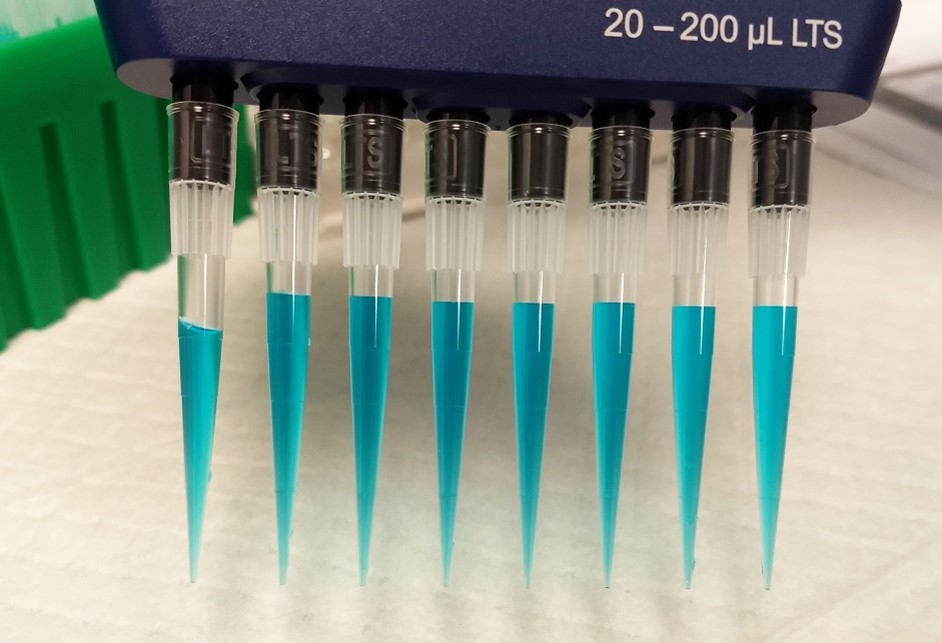
ELISA Tip 3: Use the Proper Plate Washing Technique
Insufficient washing is a common cause of high background, reduced sensitivity, and variability in immunoassays. For best results, we recommend the use of an automated plate washer or hand-held washing manifold. A wash bottle is also acceptable for many assays. The ELISA experts at ALPCO do not recommend using a hand-held pipettor to wash plates as they lack the necessary force required to reduce non-specific binding. Follow the tips for your plate washing device.
Using an Automated Washer:
- Program the wash volume, number of washes, and any soaking steps per the kit’s instructions for use. Verify the dispense volume is accurate for each channel prior to starting your assay.
Using a Hand-held Manifold
- Overfill wells when dispensing and avoid touching the tips to the bottom surface of the wells. Carefully observe each channel when dispensing to ensure they are all functioning properly.
Using a Wash Bottle
- Use a dedicated bottle for wash solution labeled with the reagent name or buffer formulation and rinse it with DI water between uses. When washing, vigorously overfill each well. Fill one row or column at a time moving back and forth across the plate, ensuring no wells are missed.
ELISA Plate Washing Trick #1: When manually washing plates with removable strips, number the strips with a permanent marker. Try a metallic silver marker for black strips. If strips fall out when decanting reagents, they are easily replaced in the proper sequence, ensuring proper data reporting.
ELISA Plate Washing Trick #2: When using a manual wash bottle, cutting the tip will often improve flow and reduce the formation of bubbles.
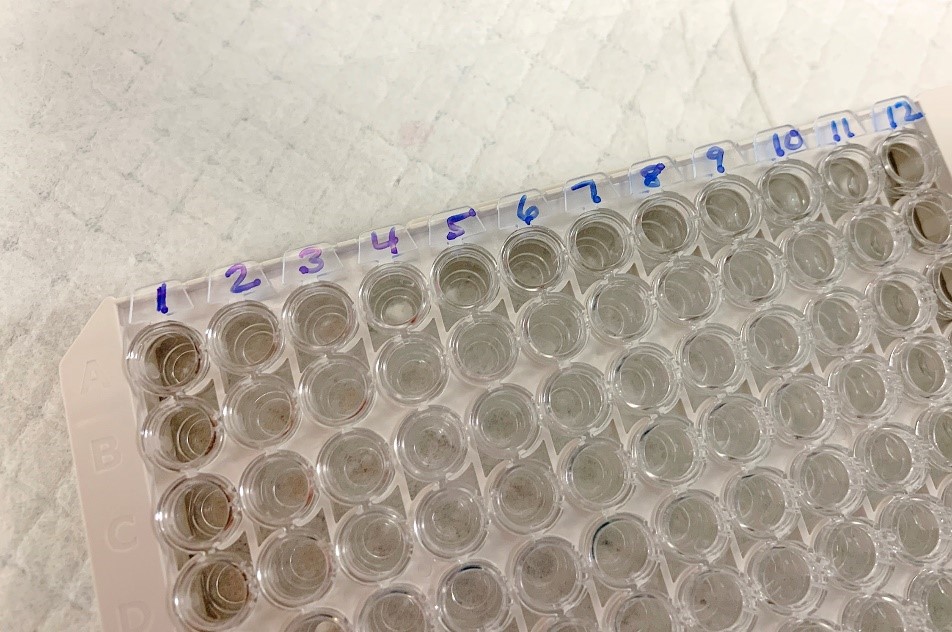
ELISA Tip 4: Use the Proper Pipetting Technique
Proper pipetting technique is vital for intra-assay and inter-assay reproducibility. Follow these tips to improve assay precision:
-
Use the same calibrated pipettes throughout your assay procedure.
-
Use the appropriate pipettor for the volume to be added.
-
Ensure your pipette is set to the correct volume and tips are on securely before each pipetting step.
-
Always change tips between samples and reagents.
-
Be consistent with your use of pipetting technique (reverse pipetting or forward pipetting) for each assay step.
-
Forward pipetting should be utilized when adding sample to buffer, adding a very small amount of one reagent to another, or adding a viscous reagent, such as Tween 20, to buffer. The full volume is dispensed, and solution can be drawn in and out of the tip to ensure delivery and proper mixing.
Pipetting Trick #1: Keep a small biohazard waste bucket on the benchtop for quick and easy tip disposal. Pipetting Trick #2: Take advantage of reverse pipetting when dispensing a reagent that tends to form bubbles, including assay buffers which may contain a surfactant.
ELISA Tip 5: Handle Samples with Care
Proper sample handling can reduce variability between replicates and between tests. Be mindful when storing, thawing and pipetting samples. Some kits have special sample handling requirements, so always review the assay’s instructions for use before receiving samples and starting the procedure. Follow these tips for proper sample handling technique.
Thawing:
- Thaw samples at room temperature.
Storing:
- Research the stability of your analyte/biomarker of interest and follow any special sample handling recommendations provided in your kit’s instructions for use.
- Limit time at room temperature and in the refrigerator. Store samples at ≤ -70°C whenever possible to prevent degradation of the analyte.
- Aliquot samples to avoid freeze-thaw cycles.
Pipetting
- Vortex samples prior to pipetting.
- Draw sample in and out of the pipette tip to coat the inside before transferring sample.
Sample Handling Trick: Inspect the pipette tip after drawing sample to ensure there are no droplets adhering to the exterior. Any droplets should be removed with a Kimwipe, taking care to avoid the open end of the pipette tip. This will ensure excess sample is not transferred and minimize variability between replicates.
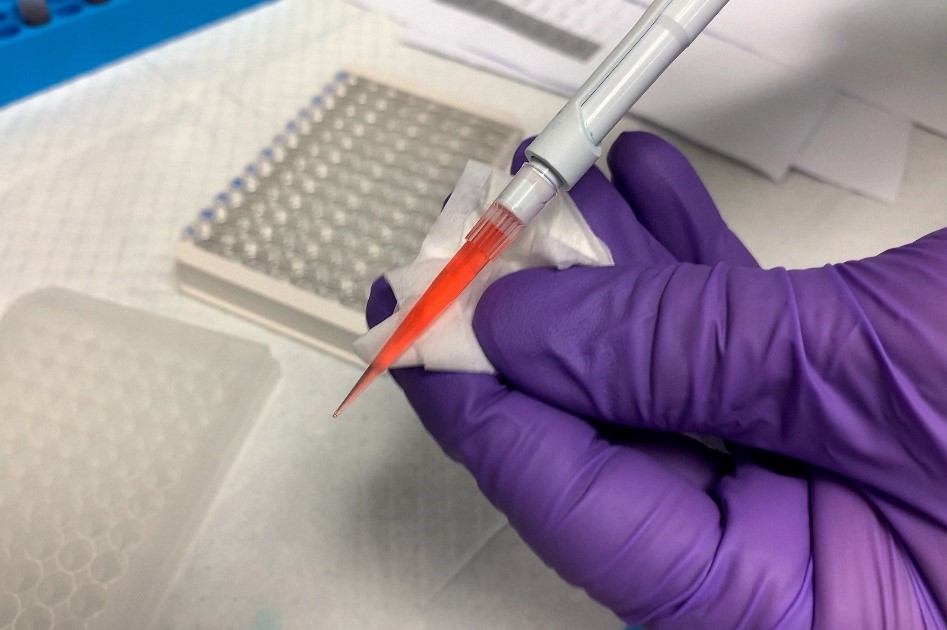
ELISA Tip 6: Carefully Reconstitute Lyophilized ELISA Reagents
Many ELISA kits incorporate lyophilized reagents to maximize shelf-life. When a liquid ELISA reagent is lyophilized, it’s freeze-dried and heated to remove the water and convert it into a powder form. Lyophilized reagents need to be reconstituted with the required buffer to achieve the final working formulation before use. Follow these tips when reconstituting your reagents:
-
Use the reconstitution buffer and volume indicated in your Instructions for Use or lot-specific Certificate of Analysis.
-
Loosen the stopper carefully to avoid dislodging any material adhering to the stopper.
-
After adding reconstitution buffer, replace the stopper and gently swirl the vial for 5 to 10 seconds. Then invert the vial three times to dissolve any material that may have dried on the stopper.
-
Unless otherwise indicated in the instructions, allow reconstituted reagents to stand for 30 minutes prior to use to ensure complete dissolution.
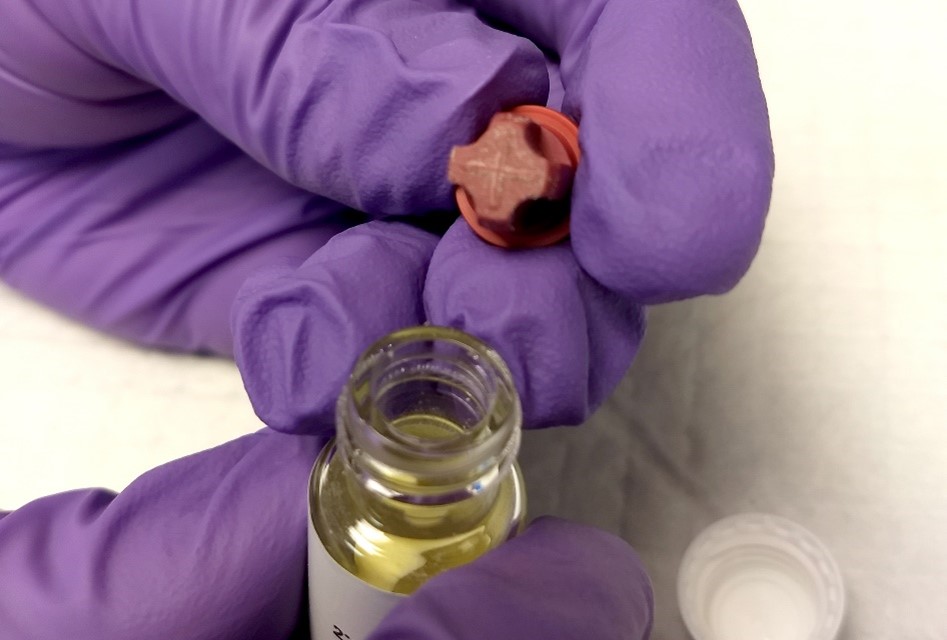
ELISA Tip 7: Plan Your Assay Before Starting
Planning your assay before starting will make the run more efficient while also reducing errors and retests. Keep the following tips in mind while planning your assay:
-
Determine the number of samples to be tested, the number of replicates to be run, and the number of plates/kits required. You can use our sample calculator to determine how many samples can be run per plate.
-
Verify reagent availability and prepare any required buffers in advance.
-
Ensure access to instrumentation and create required assay templates in the analysis software.
-
Decide whether or not a dilution plate will be used (see tip #8 for details).
-
Fill out assay and dilution plate map templates.
-
Complete the necessary calculations for reagent preparation and sample dilutions before starting the assay.
-
Keep a copy of the calculations with you at the bench.
-
Use our convenient ELISA plate map template to plan our your wells.
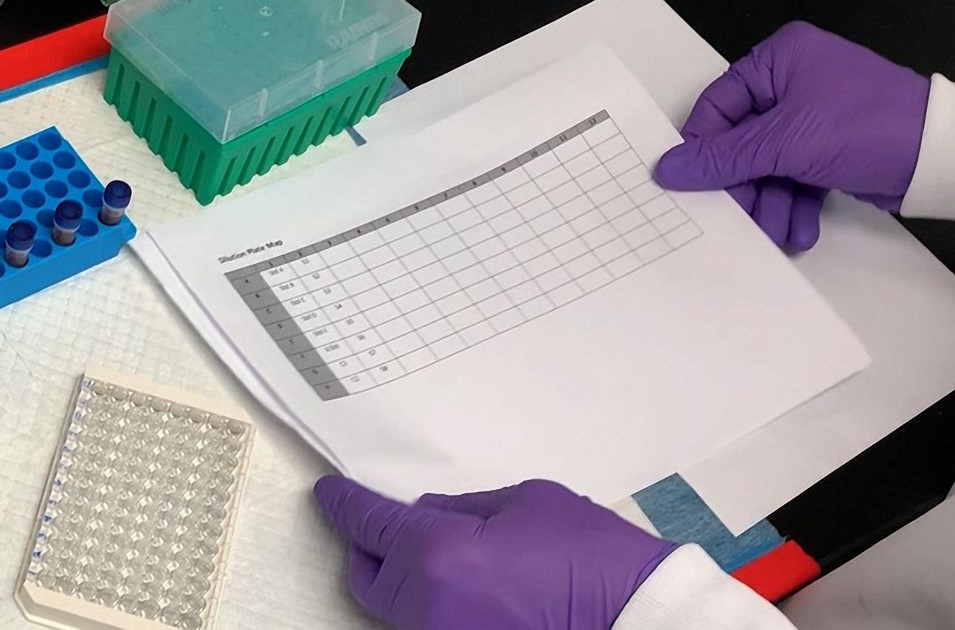
ELISA Tip 8: Take Notes While Running Assays
Many factors can affect the outcome of an assay. It is not always possible to maintain consistent laboratory conditions and ensure the quality of incoming samples. If there is a problem during the assay, keeping accurate notes will assist with the interpretation of results. Follow these tips for taking notes during your assay:
-
Record all reagents, lot numbers, and concentrations used.
-
If more than one instrument is available for shaking, washing, or reading, record the equipment and settings used for the assay.
-
Make notations regarding any unusual appearance of individual samples or volume limitations that may affect pipetting accuracy.
-
Record any errors or deviations from the recommended procedure.
-
Record any environmental conditions, such as excessive heat or cold, that may affect assay performance.
Assay Notes Trick: Keep a copy of the plate map and assay procedure at the bench. Make notations directly on the plate map (e.g. Circle a sample or record sample number and indicate “cloudy in appearance.”) and the assay protocol (e.g. “Samples incubated 10 minutes longer due to timer malfunction.”). Observations can later be transferred to a lab notebook or incorporated into an assay report.
ELISA Tip 9: Use the Proper Kit Components
Assays contain a number of components that are optimized and tested together to ensure consistent batch-to-batch performance. For most components, formulations and concentrations are optimized for individual kits. In some cases, reagent concentrations are optimized for individual kit lots. Components from different kits or different kit lots should not be interchanged. ELISA performance is only supported through the stated expiration date. After this date, performance will decline. Keep these ELISA component tips in mind:
-
Do not mix components from other kits or kit lots.
-
Contact your kit manufacturer to ask about using a component from another kit lot. In some unique cases, the use of a component from another lot may be acceptable.
-
Discard expired reagents to avoid accidental use.
ELISA Tip 10: Follow the Kit's Instructions for Use
Every ELISA kit is different, so we highly recommend reading the entire instructions for use (also referred to as the IFU or manual) to ensure special requirements are not missed. A kit’s instructions for use can be revised between lots, so always use the version that arrived with your assay. Follow these tips when reading your ELISA’s instructions for use:
-
Use the instructions that arrived with the kit box.
-
Read the instructions carefully prior to beginning an assay.
-
Verify that all materials not provided are on hand before starting.
-
Note any reagents that must be prepared prior to use.
-
Make note of any special sample handling requirements and recommended sample dilutions.
-
Strictly follow reagent volumes and incubation times in the instructions.
-
Complete all recommended wash steps.
-
Incubate plates at the proper temperature and shaking speed.
-
Shakers like this that move in an orbital motion at a very small radius and go up to a speed of 900rpm are recommended.
ELISA Tip 11: Be Cautious When Running Multiple Assays or Plates Simultaneously
Running multiple plates simultaneously can create confusion and cause errors, especially if plates are coming of the shaker at different times Keeping everything labeled can prevent mix-ups and missed steps. Take precautions when running more than one assay or more than one plate at a time. If planning to run multiple assays, remember the following tips:
-
Segregate reagents for each assay.
-
Label the side of your plates using colored lab tape and/or a permanent marker so they are easily distinguishable from one another throughout the day.
-
Prior to each incubation, label each plate sealer with the stop time and reagent to be added for the next step. For example, “Add SA-HRP at 2:15” or “Add Insulin Bio-Ab at 11:30.”
Multiple Assay or Plate Trick: Label reagents for individual assays with colored lab tape or permanent marker to avoid mix-ups. Generic reagents such as SA-HRP can have different formulations or different concentrations from one assay or kit lot to another and may not be interchangeable.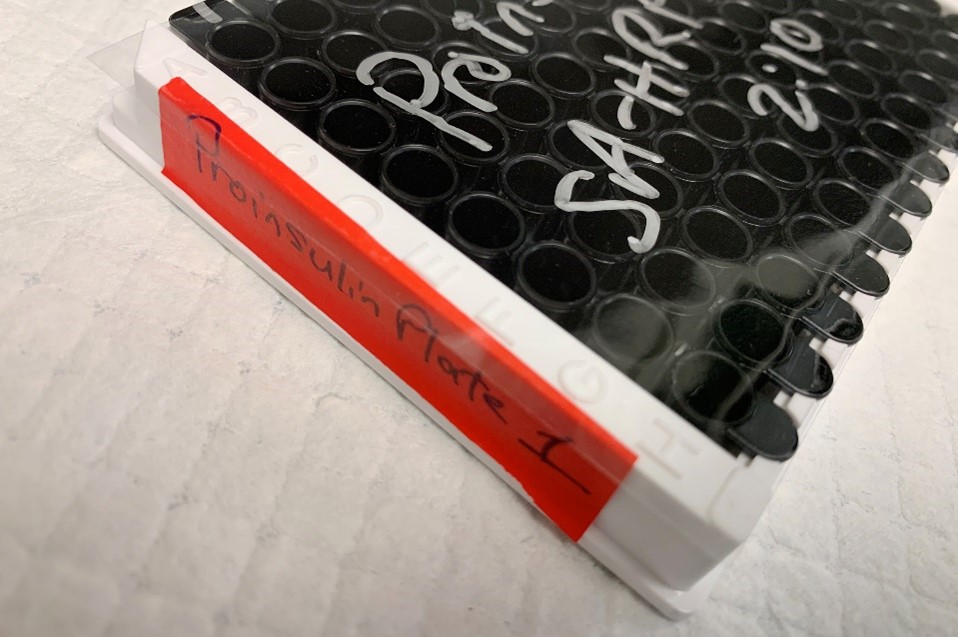
ELISA Tip 12: We're Here to Help!
In addition, we've created an ELISA Troubleshooting Guide that we think might be helpful to you! View Guide Don’t be afraid to ask questions! If you need more assistance with proper pipetting and plate washing techniques, reconstituting reagents, or have questions about a kit purchased from ALPCO, contact technical support at [email protected] or 800-592-5726.
